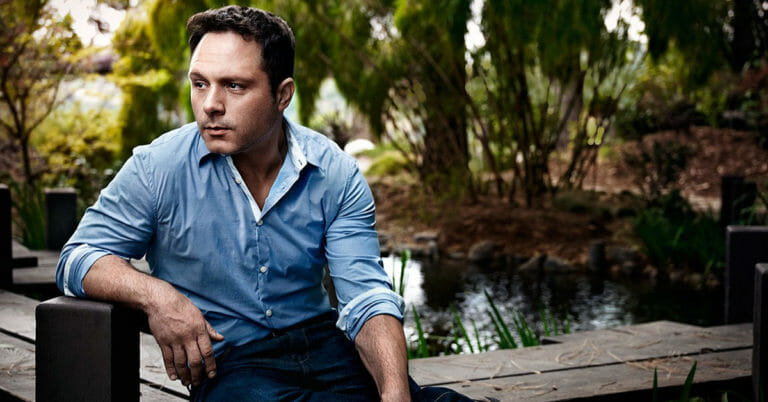By Martin Keady · November 27, 2019

The reputation of Nic Pizzolatto as a great television writer rests not just on one show but on one season of that show – the first season of True Detective (2014), rather than the “Truly Defective” (or at least partly defective) seasons that followed it. Nevertheless, the genuinely dark genius of that first season was enough on its own to elevate Pizzolatto to the first rank of television writers – those who have not just written great television drama but effectively rewritten television drama itself, by extending its range and showing exactly what it is capable of.
Nicholas Austin Pizzolatto (to give him his full name) was born in New Orleans in 1975. As his name suggests, he is of Italian origin and he has always claimed that his own upbringing was one of relative poverty. He left home when he was only 17, but rather than running away to sea (as he might have done in an earlier age) he effectively ran away to university, as he eventually won a scholarship to study visual arts at Louisiana State University. It is intriguing, but also appropriate, that of all the screenwriters and television writers I have written about for The Script Lab, he is one of the very few who did not study either literature or history at university, but instead focused on visual arts. It certainly paid off in True Detective, in which so much of Pizzolatto’s writing, especially his depiction of poverty in America’s deepest south, is extraordinarily visual. Indeed, at the end of True Detective, he posits the grand theory that all storytelling and writing can be thought of in purely visual terms. But we will return to that grand theory later.
Download the series bible for TRUE DETECTIVE here for free.
Pizzolatto did eventually change majors to study English and Philosophy, which he graduated in, but after graduating he did not immediately put his academic studies to good use. Instead, in time-honored fashion for writers everywhere, having studied Shakespeare and Plato he then became a barman in America’s “Slacker City”, Austin (as immortalized in Richard Linklater’s Austin-set debut, Slacker (1991)). For much of the next five years, the only “writing” that he did was technical writing, including manuals for different electronic products, to earn extra money. Fortunately, before he became a complete barfly (as happens to one of the two main characters in the first season of True Detective), he went back to college, at the University of Arkansas, to study creative rather than technical writing.
In particular, his first novel Galveston (2010), a thriller about a hitman who wrongly thinks that he is dying), was a great success, winning several awards and being translated into several languages, before finally being adapted for the screen in 2018. Pizzolatto himself contributed to the screenplay, but, after professing himself unhappy with the finished film, he insisted that his own name was not used in the credits but a pseudonym, Jim Hammett, which is surely a nod to one of the “twin kings” of noir, Dashiell Hammett (the other being, of course, Raymond Chandler).
As a result of the success of Galveston, Pizzolatto became a television writer. His first credit (indeed, his only other credit before creating, writing and producing True Detective) was on the US remake of the original “Scandi-Noir”, The Killing (or Forbrydelsen, in the original Danish), the show that made Sofie Gråbøl and Scandinavian knitwear internationally famous. The US remake was not nearly as successful (or powerful) as the Danish original, but it gave Pizzolatto the credit and, equally importantly, the connections to sell True Detective to HBO, the home of The Sopranos and The Wire. And if, ultimately, True Detective could only produce one truly great season, as opposed to the multiple seasons of both The Sopranos and The Wire, that one season alone meant it still merited comparison with those masterpieces, which, along with Mad Men, form the holy trinity of late 20th century/early 21st century television drama.
True Detective (the first season) is the story of two detectives, Marty (played by Woody Harrelson) and “Rust” (played by Matthew McConaughey), who initially work together on a murder case, then fall out with each other disastrously (when one of them has an affair with the wife of the other), before getting back together nearly two decades later to try and solve that initial case when it is reopened, because it appears that the killer (who had been thought to have perished in a firefight at a remote ranch) is still at large. So True Detective is epic in the true sense of the word, in that it unfolds over a long period of time, beginning in the mid-1990s and then coming right up to date in 2012, when the case is reopened and the original story resumes.
True Detective is a classic example of how art combines familiarity with surprise – of how a familiar, even apparently clichéd form, can be altered, or even transformed, by the addition of an element or elements that have never been used in that form before. At the very beginning, True Detective appears like so many other “odd couple” cop films or TV shows, as the almost excessively friendly Marty tries to bond with the far more aloof Rust. However, as they examine the crime scene, and then return to their car to plan their investigation, Rust briefly mentions “linguistic anthropology” (the study of how language influences social life and human life in general) and it is clear that we are not in a conventional cop movie. True Detective, and its two detectives, are going to be far more intelligent (and unashamedly intelligent) than that.
Rather like the first season of The Wire began by showing “the other America” of the “projects”, the housing schemes in which the inner-city drugs trade is largely conducted, so True Detective shows “another America” in its depiction of Pizzolatto’s home state of Louisiana. As Marty and Rust reopen old cases in an attempt to find a link with the case that they are currently investigating, they travel deep into the state, into the waterlogged Bayou and the world of the “po’ white folk” (or, as they are more commonly and pejoratively referred to, “po’ white trash”) who inhabit a world of trailer homes and trailer parks that is almost literally disappearing off the edge of the world, as climatic change causes the rising sea levels that will eventually consume much of Louisiana.
The story then unfolds in two different time periods: the mid-90s, when Marty and Rust first meet; and then 17 years later, when they are grilled by another pair of police officers about their initial inquiry, as it appears that the killer they thought they had caught (or at least killed in a shootout) was not actually the killer at all.
Indeed, some of the problems of plotting and characterization that eventually overwhelmed the second season are present even in the feted first season. In particular, in the middle of the first season, as Marty and Rust try to track down the killer, the story almost descends into unrealistic farce, as they infiltrate biker gangs who they believe are involved in the murder. However, just as the first season of True Detective literally appears to have lost its plot, it recovers its balance and returns to the main storyline, which is given a horrific new twist when the ritualistic murders begin again and it becomes apparent that the man Marty and Rust had thought was the killer clearly wasn’t.
The response to this new information is fascinating: Marty, now divorced, seems to descend into brutality (even threatening and blackmailing a young man who has had the audacity to date his daughter); while Rust descends into alcoholism, becoming the kind of barfly that Pizzolatto might himself have become if he had not become a writer. Finally, however, the two men put their differences aside (which are ultimately based on their respective treatment of women) to try and find the real killer.
Without giving any plot points away, it encapsulates all that is best about the show: a meticulous attention to procedural detail; the creation of an atmosphere that almost literally oozes sin and sedition; and ultimately the final exchange between the two cops, in which they finally come to terms with everything that they have been through. As Rust puts it, in the end everything comes down to a battle between light and dark. It appears that the dark has triumphed (given the appalling series of murders that the men have been unable to prevent), but as Marty picks out city lights in the distance, he concludes, “Looks like the light’s winning”. Whether this is the truth, or just the lie that he has to tell himself to keep on living, it is beautifully poetic and links True Detective to the entire, millennia-old tradition of storytelling, which began around camp or even cave fires.
In retrospect, it is unsurprising that the following seasons of True Detective failed to match up to the majesty of the first. The fundamental problem is that the template that Pizzolatto created – a long and complex story, taking place over decades, involving two very different but equally shrewd (if not wise) detectives – could only really be used once, rather than being repeated with diminishing results. Nevertheless, the glory of the original True Detective is such that even if there are a dozen more series, it will still shine like the brightest beacon in the Stygian gloom that is so much modern-day television.
 Martin Keady is an award-winning scriptwriter whose work has been produced for film, television, stage and radio. His major credits include: The Final, a short film about the famous ending of the 1979 FA Cup Final, which was shown on Channel Four; Moon the Loon, a play about the legendary Who drummer, Keith Moon, which was premiered at The Edinburgh Festival; and a collection of love poetry, Shards, extracts from which have been broadcast on Radio Four.” http://theshakespeareplays.com/
Martin Keady is an award-winning scriptwriter whose work has been produced for film, television, stage and radio. His major credits include: The Final, a short film about the famous ending of the 1979 FA Cup Final, which was shown on Channel Four; Moon the Loon, a play about the legendary Who drummer, Keith Moon, which was premiered at The Edinburgh Festival; and a collection of love poetry, Shards, extracts from which have been broadcast on Radio Four.” http://theshakespeareplays.com/
Photo credit: Art Streiber via Vanity Fair
For all the latest from The Script Lab, be sure to follow us on Twitter, Facebook, and Instagram.